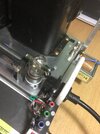Not as simple as I thought.
Preparing to connect 2 Heathkit 54-30transformers: Single Pri/Sec windings for 110v to 1800v at 400mA with a CT. I need more plate current. The 54-30's are potted with no markings regarding phase (direction of windings around core), I don't have an oscilloscope but found a few vids on determining phase with an analog meter & a small battery. Hope I'm mistaken and someone will reply: just hook'em up phase unimportant. I'm afraid of ruining the transformers and making a smell my wife will remind me of for years to come. I ordered SHV fittings, proper wire and built a safe but small enclosure for the second unit. Want amp to work without 2nd unit as it does now.
I thought I could use a second AC plug for the 2nd transformer tapping another AC outlet. Need to re-think that despite polarized plugs.
Still processing my resort to a COR keying board. Passed through the Denial stage and inching toward Acceptance, get on with my life Thoroughly defeated on that count but it will work, maybe add a relay.....feel better about it. Not much I can find on how the newer Yaesu's key external amps and joined the FT-891 group but mostly plug n play tales. It seems to be a pulse trigger but I'm >$100 on keying so next move must work.
++++++++++
EDIT: Found a "Transformer Dot Convention Finder" kit. PCB only $10 with parts list uses a 555 Timer to inject signal. It looks simple fast build, useful tool and price is right. See:
https://www.pcbway.com/project/shareproject/Transformer_dot_convention_detector.html
2nd EDIT: 1993 ARRL Handbook's section on parallel transformers (only 3 paragraphs & 1 diagram) makes no mention of phasing (p6-2). It does suggest using a 3rd transformer's CT secondary to equalize the 2 Secondaries being combined with the 3rd Primary left unconnected.
Maybe I'm making an issue where there is none. I have a choice btwn rabbit hole and just hooking'em up.
Preparing to connect 2 Heathkit 54-30transformers: Single Pri/Sec windings for 110v to 1800v at 400mA with a CT. I need more plate current. The 54-30's are potted with no markings regarding phase (direction of windings around core), I don't have an oscilloscope but found a few vids on determining phase with an analog meter & a small battery. Hope I'm mistaken and someone will reply: just hook'em up phase unimportant. I'm afraid of ruining the transformers and making a smell my wife will remind me of for years to come. I ordered SHV fittings, proper wire and built a safe but small enclosure for the second unit. Want amp to work without 2nd unit as it does now.
I thought I could use a second AC plug for the 2nd transformer tapping another AC outlet. Need to re-think that despite polarized plugs.
Still processing my resort to a COR keying board. Passed through the Denial stage and inching toward Acceptance, get on with my life Thoroughly defeated on that count but it will work, maybe add a relay.....feel better about it. Not much I can find on how the newer Yaesu's key external amps and joined the FT-891 group but mostly plug n play tales. It seems to be a pulse trigger but I'm >$100 on keying so next move must work.
++++++++++
EDIT: Found a "Transformer Dot Convention Finder" kit. PCB only $10 with parts list uses a 555 Timer to inject signal. It looks simple fast build, useful tool and price is right. See:
https://www.pcbway.com/project/shareproject/Transformer_dot_convention_detector.html
2nd EDIT: 1993 ARRL Handbook's section on parallel transformers (only 3 paragraphs & 1 diagram) makes no mention of phasing (p6-2). It does suggest using a 3rd transformer's CT secondary to equalize the 2 Secondaries being combined with the 3rd Primary left unconnected.
Maybe I'm making an issue where there is none. I have a choice btwn rabbit hole and just hooking'em up.
Last edited:


